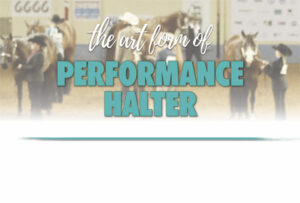The Art Form of Performance Halter
Click here to read the complete article
300 – September/October, 2022
The Performance Halter classes are by far the largest halter classes at most shows. The popularity of this class has steadily increased over the past several years, and many all-around exhibitors find themselves presenting their horses as a requirement for high point awards, or at the very least as a way to gain additional points toward the high point standings.
Just like with any other class, there is an art form to presenting a horse in Performance Halter. Judges are looking for specific characteristics in horses shown in this class, and while the designation of the class is for horses that are desirable for riding, there remains the overall halter conformation requirements, as well. The theme of the Performance Halter class is “form to function.” Judges want to see a horse that is nicely groomed and turned out, set up square and shown in the best light. In short, the horse should be placed in the best possible position for them to be evaluated for their form to function. The functionality of the Performance Halter horse is to engage in performance classes. Therefore, the horses are being critically evaluated for their conformational ability to successfully do that.
The Experts
Kristy Starnes is a successful trainer and carded judge. When she is judging a class, she looks for a horse that is without major conformational flaws that can also be ridden in performance events. She says, “Performance Halter is very similar to regular halter. I am looking for many of the same characteristics in both types of horses, but the Performance Halter is a little different because I am looking for a horse that can be ridden as well as one that has nice overall conformation.”
Garth Gooding is a carded judge, as well as a trainer and exhibitor in the Performance Halter classes. He says that when judging he is looking at, “angles of the shoulders, hocks, hips, and top line. Those angles are very important and can tell me a lot about the horse’s abilities. The horses should have a nice neck and head, too. They need to be built in a way that allows the horse to have a higher quality of movement and should not have the same level of muscle mass that a horse shown in a regular halter class would have.” He went on to share that as a judge he sees horses that are “more set in the hocks, which would be undesirable in a regular halter class.” Garth prefers horses that are “a little straighter in the hock because it tends to allow them to last longer as a riding horse.” This is his personal preference as a judge, and so he says, “I tend to place a higher emphasis on it than another judge may.”
Click here to read the complete article
300 – September/October, 2022











